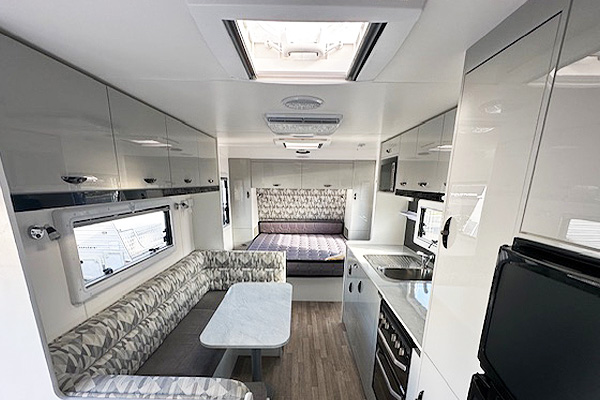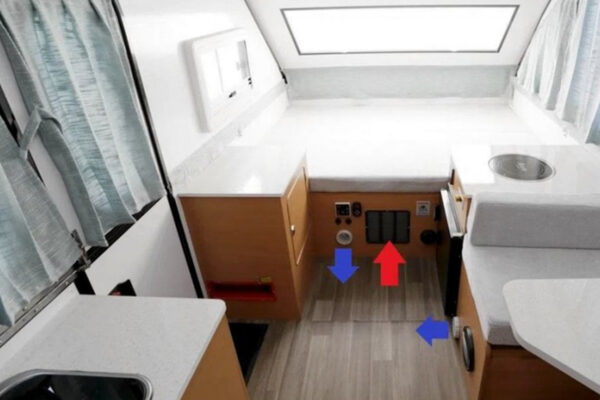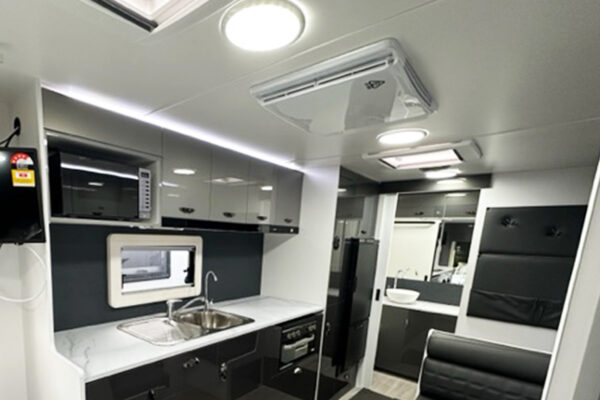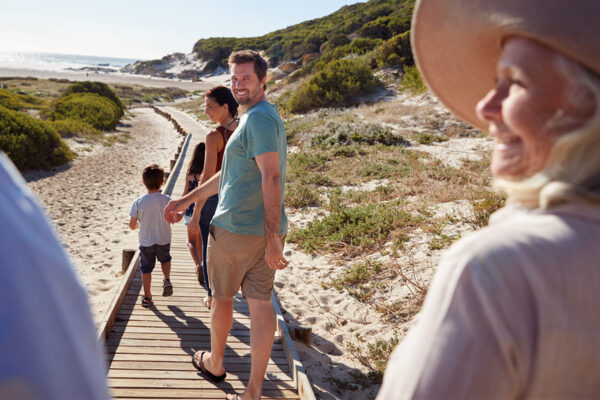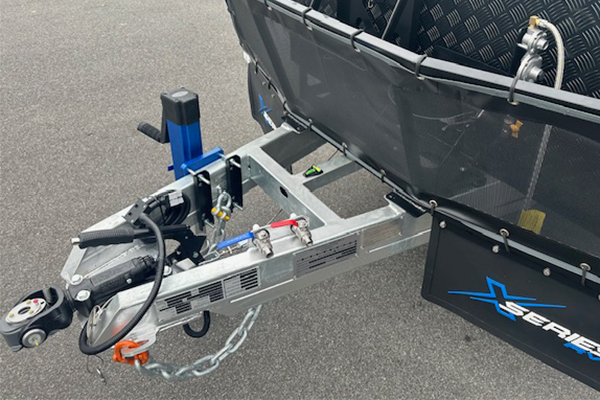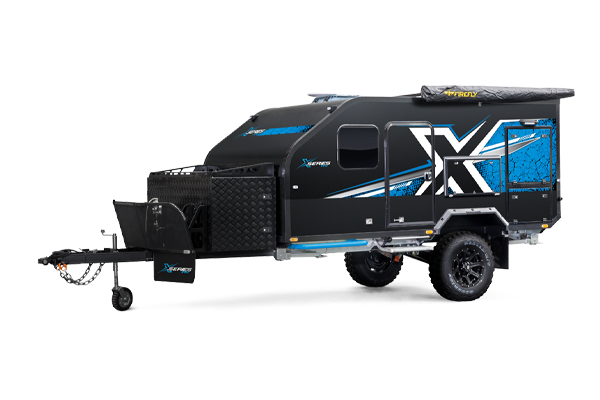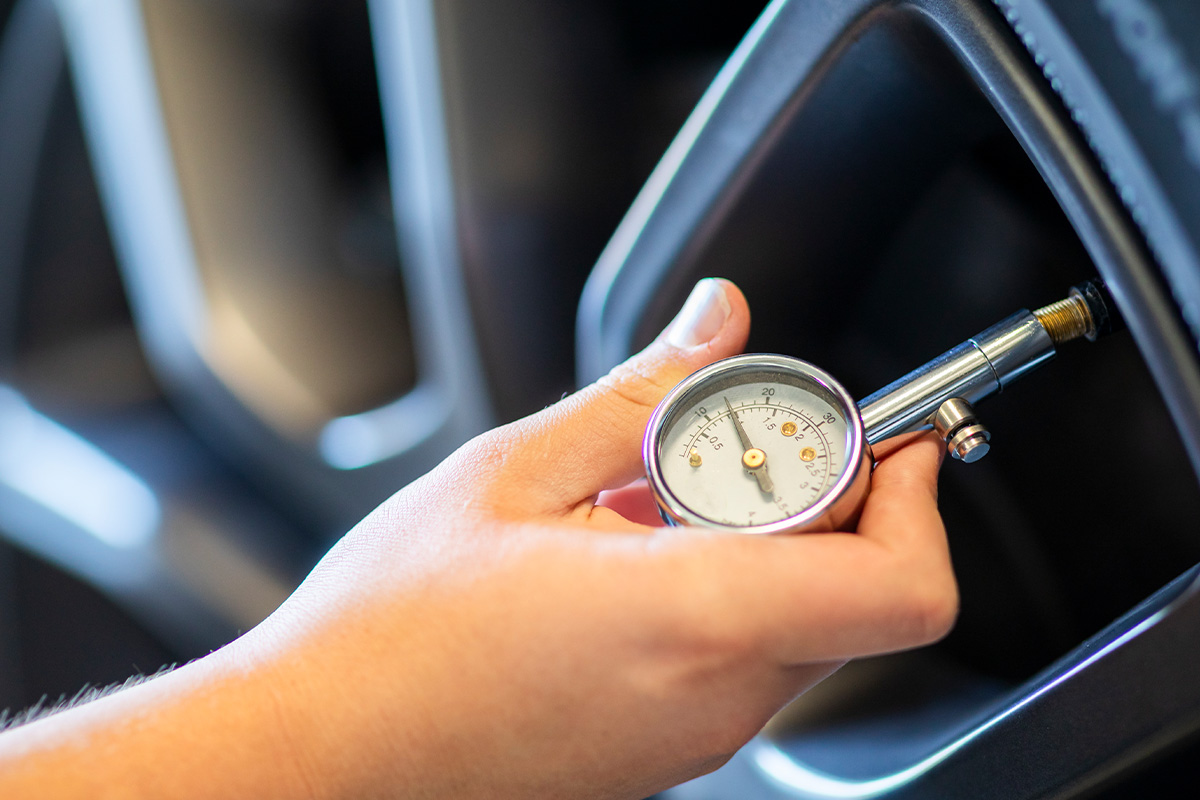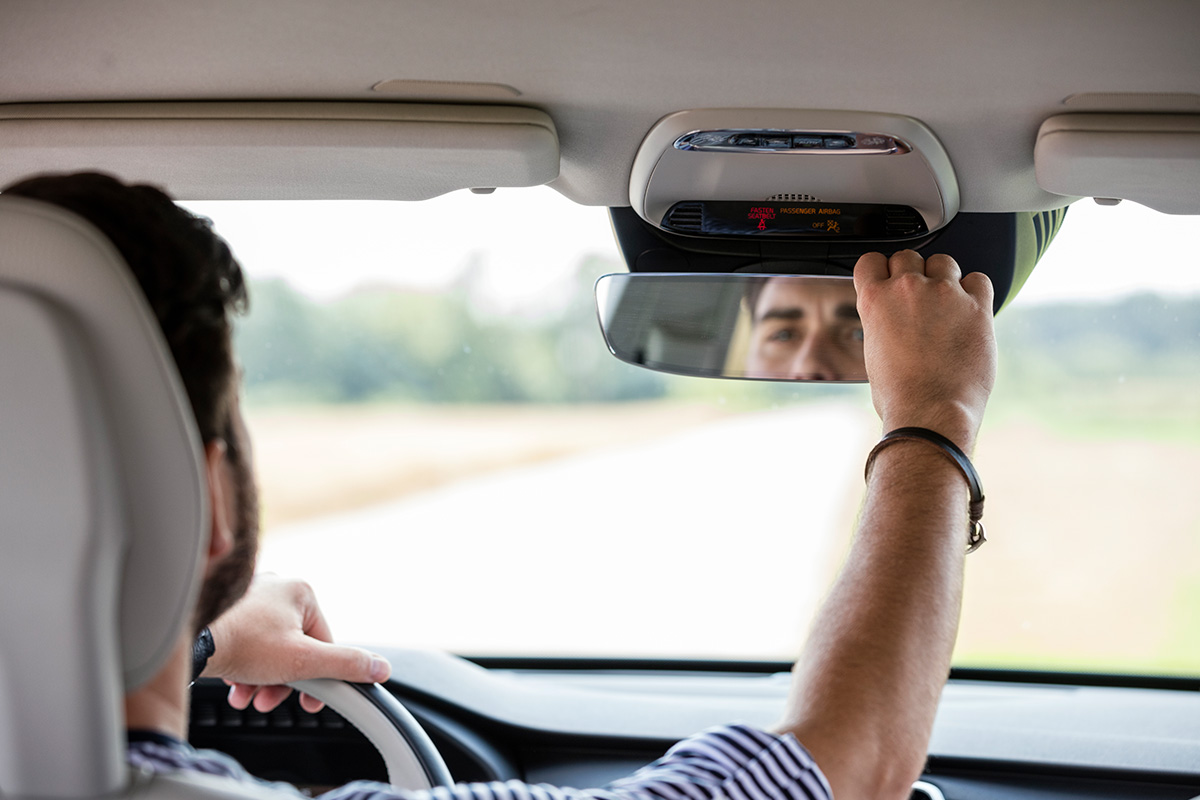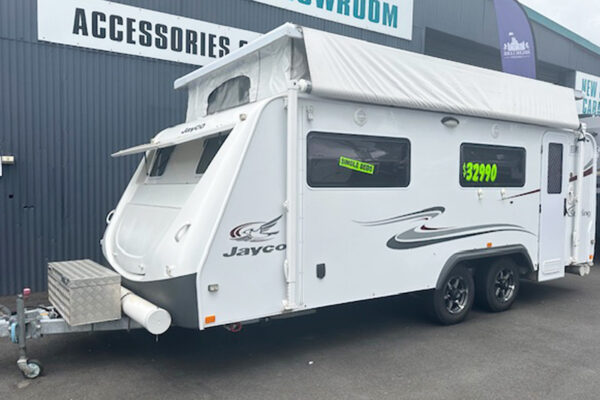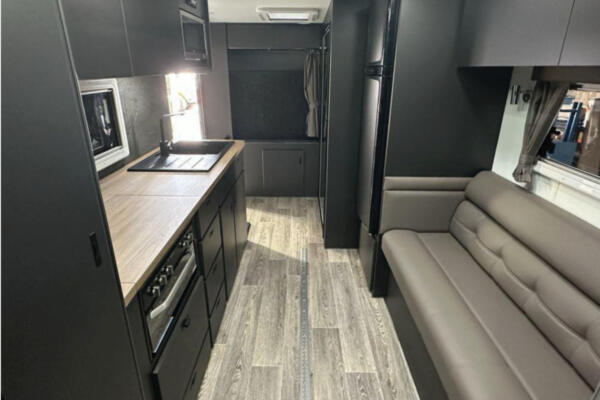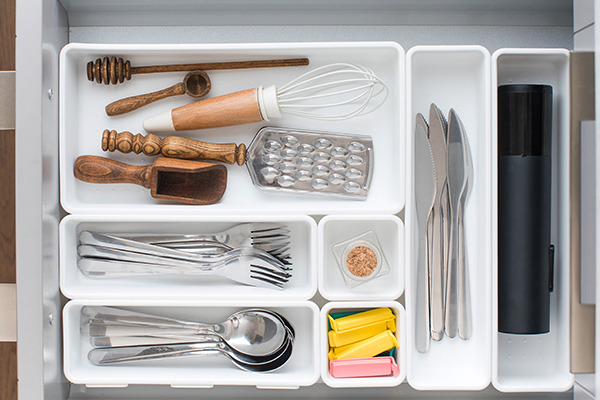Keep up to date with all things caravanning

Best Caravan Air Conditioner: 2024 Guide
May 24, 2024
Having an air conditioner in your caravan will make a world of difference to life on the road, but they are not all the same, and there are things you need to consider before choosing the best caravan air conditioner. We compare the most popular caravan air conditioners, their specifications and special features, and list things to consider when choosing the best air conditioner for your caravan.
Our Top Air Conditioner Picks
At Canterbury Caravans, our top picks for caravan air conditioners are:
Best Pop-Top Air Conditioner
Cool J HB9000 Plus Under Bunk Air Conditioner
The Cool J HB9000 is our top pick for the best pop-top air conditioner on the market. It features Wifi control, a premium compressor for improved efficiency, and is extremely quiet. It is reverse-cycle heating and cooling.
Best Camping Air Conditioner
The Gree reverse cycle RV air conditioner is a great entry-level air conditioner for most caravans and our pick of the best camping air conditioner. It is specifically designed for caravans and built for harsh Australian climates. It is innovative, stylish, robust build, ultra-low profile, and has super quiet operation. The 2.5kW model is great for smaller caravans, and the 3.5kW ideal for larger vans.
Best Air Conditioner for Off-grid & Larger Vans
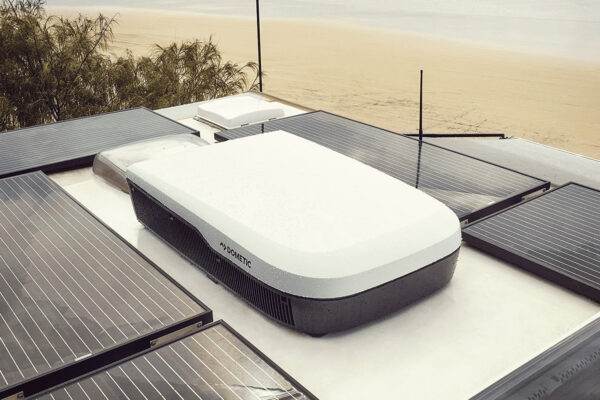
The Fresh Jet is an inverter-style air conditioner and our best pick for off-grid or larger caravans. It has a larger capacity and the inverter technology reduces power consumption. This technology controls the amount of power that is supplied to the compressor motor within the air conditioning unit which eliminates unnecessary operation. The inverter is able to change the motor speed according to room temperature. It cools when the temperature rises and heats when it falls below a specified reading. The Fresh Jet would also suit customers with off-grid setups, and is more power efficient when running off inverters.
Comparing Caravan Air Conditioners
When comparing caravan air conditioners, it is important to consider the caravan type, price, size and cooling and heating capacity. To assist you in finding the best air conditioner for your van, we have listed a comparison of the best-selling and most popular caravan air conditioners on the market in the categories of rooftop and built-in.
*The tables below compare Australia’s most popular and best-selling air conditioner brands, including price (at the time of publication), the length of vehicle they are suitable for, and heating and cooling capacity. With this information, you can get a fair idea of the type of caravan air conditioners available that will suit your size caravan and the approximate cost you will need to spend.
Rooftop Air Conditioners
Rooftop Air Conditioners are air conditioners mounted on the roof of the caravan. They blow air down through a distribution box into the caravan. These are the most common types of caravan air conditioners.
| Air Conditioner | Dometic FreshJet 7 Series Pro Roof Top Air Conditioner with ADB | Houghton Belaire3400 Air Conditioner Caravan Reverse Cycle Roof Top Air Conditioner | Truma Aventa Comfort Reverse Cycle Roof Top Air Conditioner | Furrion 3.5kW Rooftop Air Conditioner | myCOOLMAN |
| Estimated Price | $2400 | $1800 | $2099 | $1600 | $2099 |
| For vehicle size (length) | Up to 6m/19ft | Up to 6.5m/21ft | Up to 7.5m/ 24ft | Up to 7.5m/24ft | Up to 7.5m/24ft |
| kW rating | 2.9kW | 3.2kW | 2.4kW | 3.5kW | 3kW |
| Heating/cooling capacity | Heating Capacity: 2700W. Cooling Capacity: 2900W | Heating Capacity: 2800kW.
Cooling Capacity: 3200kW |
Heating Capacity: 1700kW.
Cooling Capacity: 2400kW |
Heating Capacity: 3600W.
Cooling Capacity: 3500W |
Heating Capacity: 3000W.
Cooling Capacity: 3000W |
| Operating Temperature range | -2°C to 52°C | 5°C to 50°C | 4° to 43°C | -7°C-43°C | -5°C to 52°C |
| No. of blower speeds | 4 | 3 | 3 | 3 | 4 |
| Dimensions
External WxDxH |
700 x 1090 x 242mm | 223 x 850 x 1122 mm | 660 x 248 x 1008mm | 738x1056x253mm | 718X1107X225mm |
| Additional Features | Air purifier
WiFi/BT Optimised air flow Quiet operation Remote Bluetooth |
Remote control
LEd display Sleep functions Outdoor fan grill Defrosting technology |
Slimmest air distributor on the market
Energy saving Powerful cooling |
Remote control
LED display Sleep mode |
Sleek, modern design
Full bluetooth capability Latest technology for reduced power consumption |
Built-in Air Conditioners
A caravan built-in air conditioner is mounted inside the caravan and vented through the floor through ducting. They are also called under-bunk air conditioners.
| Air Conditioner | Truma Saphir Comfort RC Air Conditioner | Cool-J HB9000 Plus Underbunk Reverse Cycle Air Conditioner |
| Estimated Price | $2135 | $1420 |
| For vehicle size | Up to 6.5m/21ft | Up to 6.5m/21ft |
| kW rating | 3.5kW | 2.7kW |
| Heating/cooling capacity | Heating Capacity: 3600W.
Cooling Capacity: 3500W |
Heating Capacity:2700W
Cooling Capacity:2600W |
| Operating Temperature range | -7°C-43°C | -7°C-43°C |
| No. of blower speeds | 3 | 3 |
| Dimensions
External WxDxH |
738x1056x253mm | 398X296X734mm |
| Additional Features | Compact unit can be stored in storage compartment or under a bench seat
Remote control Integrated heat pump Highly efficient Extremely lightweight |
Space saving and low noise
Compact unit can be stored in floor Remote control LED operating panel |
What to Consider When Choosing the Best Air Conditioning Unit
With so many caravan air conditioners on the market, it can be daunting to decide on the right unit for your van. There are all sorts of differentials to consider, like the type of air conditioner, size, power consumption, and price. Other factors include where you will travel and how the unit will be installed. This comprehensive guide explains everything you must consider to find the most suitable air conditioner for your caravan.
Types Of Air Conditioners
There are two main air conditioners for caravans: rooftop and built-in (under-bunk) units. While the roof-mounted air conditioner is the most popular type on the market, built-in units are effective cooling and heating solutions as well. Each type of unit has advantages and disadvantages, which will depend on the caravan you have and how you use it. We outline the difference between a rooftop and a built-in unit to help you decipher the best type of air conditioner for your caravan.
Rooftop Air Conditioners
Rooftop air conditioners are the most common air conditioners and are mounted on the caravan roof. They are easy to install and don’t take up much room. These units are made to fit into two opening sizes in the caravan’s roof, either 360mm x 360mm or 400mm x 400mm. While a rooftop air conditioner will add height to the overall caravan height, it will not impact the caravan’s aerodynamics, so wind noise and stability are unaffected.
Advantages of Rooftop Air Conditioners:
- Space efficiency. They take up no space in the caravan interior.
- Optimum cooling capacity. Cool air sinks to the floor, which will cool the caravan more efficiently and evenly.
- Easy to install. Installing a rooftop caravan is easier than a built-in one as it requires no modifications to its interior.
- Accessibility. Rooftop air conditioners are easy to access for maintenance or repairs.
Disadvantages of Rooftop Air Conditioners:
- Height increases. The size of a caravan is a key factor that affects safety and usability, so adding any height needs to be considered. Caravan height is impacted by accessories like air conditioners and needs to be considered for height restrictions in parking areas, bridges, garages and storage areas.
- Limited to caravans with solid roofs. A rooftop air conditioner is only suitable for a caravan with a strong roof. Other caravans, like pop tops or small campervans, will not have a roof that can withstand the weight of a rooftop air conditioner.
- More expensive. Rooftop caravan air conditioners tend to cost more than their built-in counterparts.
- Takes up roof space. With some of the roof space taken up, there is less room if for solar panels if you want to install them.
Ideal for:
- Any type of caravan with a fixed roof.
Built-in (Under-bunk) Air Conditioners
As the name suggests, a built-in air conditioner is one that is fixed inside the caravan, either under a bench, in a cupboard or storage compartment, or under the floor. Vents that distribute the cool air are located on the floor.
Advantages of Built-In Air Conditioners:
- Do not need a strong roof. Built-in air conditioners eliminate the need for a strong roof and offer an effective cooling solution for caravans that cannot support the weight of a rooftop air conditioner.
- Compact design. The small and compact design means the unit can be installed in a variety of locations inside the caravan.
- Affordable. Built-in air conditioners tend to be more affordable than rooftop units.
Disadvantages of Built-In Air Conditioners:
- Cooling limitations. While this unit can cool a caravan effectively, it is not as good as a rooftop caravan, as the air is directed from the floor upwards. Cooling vents on the floor are less effective than cooling vents from the ceiling. This is because hot air rises and cool air falls so the cool air is less evenly distributed.
- Uses space. As these air conditioners need to be built into the caravan’s interior, they can take up valuable space that might otherwise have been used for other living comforts or storage. It might be built into a storage cupboard or under a bench.
- Requires ducting. Built-in caravan air conditioners all require ducting and often that needs to be purchased separately.
- Limited choice. These units have much less variety than rooftop air conditioners so the choice is limited.
Ideal for:
- Pop-top caravans, small caravans, or camper trailers that go on corrugated roads.
Types of Heating & Cooling Systems
Another important factor to consider when researching caravan air conditioners is how the heating and cooling work. Caravans have either a reverse-cycle system or a heating element system. Both systems provide cooling and heating, but the reverse-cycle system has become more popular in recent years, while heating elements can still be found in older caravans. The main difference between the two concerns energy efficiency and ambient temperature which we will explain in more detail here.
Reverse-Cycle Air Conditioning Systems
Reverse-cycle air conditioning systems work like refrigerators and use a compressor and refrigerant to cool the caravan down. In cooling mode, the system withdraws the hot air from inside the caravan, and then liquid refrigerant is pumped in, which turns into vapour. This refrigerant is then passed over an evaporator coil that removes the heat from the indoor area so the fan can blow the cold air back in. In heating mode, the reverse cycle system also uses the refrigerant gas passing through an external coil but absorbing the heat from the outside air. The refrigerant is then compressed and warms up, and the hot air is distributed into the van. These are used in most caravan air conditioners today.
Advantages of Reverse-Cycle Air Conditioning Systems:
- Energy efficiency. The reverse-cycle system uses a refrigerant system, so there is no extra energy/electricity/battery required for power.
- Ventilation. Because there is no gas required for a reverse cycle system, there is no issue with gas seeping into the caravan and therefore, the caravan will always have clean air.
Disadvantages of Reverse-Cycle Air Conditioning Systems:
- Heating problems. When the ambient temperature is very cold outside (close to freezing), it is possible that some of the components on the system will freeze up and cause the heater to stop working. If you are travelling to extremely cold temperatures, it is recommended that you install a separate heating system.
Heating Element Air Conditioning Systems
This air conditioning system uses a heat exchanger to cool the air and an electrical heating element to warm it. These are only found in older caravan air conditioners.
Advantages of Heating Element Air Conditioning Systems:
- Heating capacity. The heating element system will work in freezing temperatures and provide constant heat, unlike the reverse cycle, which may freeze up
Disadvantages of Heating Element Air Conditioning Systems:
- Not energy efficient. The heating element uses a lot of power and so is not energy efficient, particularly if you need cooling and heating regularly. Make sure you have access to an alternative power source if you are mainly relying on a generator.
Air Conditioner Size
Choosing the right size air conditioner for your caravan is imperative as it will impact its efficiency. A unit too small for your caravan will not cool it properly, while an oversized air conditioner may work too well and cause the caravan to be uncomfortably cold. There is no point buying a compact, lowline roof-top unit only to find it is too small for the van. To calculate the correct size, two factors must be considered – the size of your caravan and the air conditioner’s capacity.
An air conditioner’s capacity measures how efficiently the unit removes heat from the caravan. Cooling capacity is measured in kilowatts (kW) that usually range from 2kW to 3.5kW. The larger the caravan, the bigger the capacity required. As a general rule, an air conditioner with a capacity of 2kW to 2.5kW is suitable for a caravan up to 5 metres (16ft). Caravans that measure up to 6 metres (19t) will most likely require a capacity of 2.5kW to 3kW, and the largest vans up to 7.5 metres (25ft) will need 3kW plus for optimal efficiency.
Air Conditioner Weight
Some air conditioners weigh as much as 50 kilos or more, which adds weight to the overall weight of the caravan, affecting fuel efficiency and handling. As all caravans have a maximum weight limit, it is important to take into account any extra appliances like air conditioning units to make sure the total weight is legal. If you choose a roof-top unit, check the load-bearing capacity for the caravan roof.
Power Consumption
Caravan air conditioners are one of the appliances in a caravan that use the most power. Running at full speed, a caravan air conditioner will use about 1000 to 2000 watts of power, compared to 100 watts for a fridge or 50 watts for a fan. With this in mind, power consumption needs to be considered in the type of air conditioner you choose, given its large energy use.
The main reason power consumption will be a big issue is the power source you plan to use. Caravans can use a variety of power sources – caravan park/campsite power, generators, batteries and solar panels. If you are going to run your caravan air conditioner solely from a generator, then it is imperative you take into account power consumption. The generator will need to power the air conditioning unit and any other appliances when you are off-site, so the right size will be crucial.
To ensure you have the right generator, you need to find out the amount of power your caravan air conditioner will require to run. This is explained in the wattage and most caravan air conditioners require between 2000 to 3000 watts to start and 1000 to 2000 watts to run continuously. This means your generator will need to have an output of about 2500 to 4000 watts to supply enough power to the air conditioner and other appliances.
Installation
Another factor to consider when looking for the best caravan air conditioner is how you can install it. The difficulty of installation will depend on whether it is a rooftop or a built-in unit and the caravan set-up. Roof-top units are usually placed in an already dedicated cut-out in the roof. However, built-in models need a specific compartment or storage area inside the caravan.
If you are thinking of installing a roof-top air conditioner, you need to make sure the roof is structurally capable of supporting the weight of the unit and that there is ample space to place it. It is a good idea to have additional support with adaptors and H-frames when installing a roof-top unit.
- Adaptors. You will need adaptors to mount the unit safely. For instance, if you have a unit that measures 360mm but want it to fit into a 400mm space, you will need an adaptor to fix it into position. You can also use adaptors for extra support on the roof if installing a roof-top air conditioner.
- H-Frames. This accessory fits on the roof of the caravan for added stability.
Built-in units need plenty of space within the caravan so it is important to check the dimensions of the air conditioner against the available interior room before purchasing an air conditioner. When considering a built-in unit, look at the caravan in terms of ventilation and accessibility for repairs and maintenance as well as space. When measuring the caravan’s interior, be mindful that you may need to make modifications to accommodate the air conditioner.
While most caravan air conditioners come with clear installation instructions, it is always wise to consider professional installation.
Caravan Insulation
Caravan insulation is a significant factor in how well the air conditioner will keep the van cool. When you look at the air conditioner’s size and capacity, remember it is based on a caravan with effective insulation. If you have an old caravan with insufficient insulation, the air conditioning unit will not retain the temperature, and you may need to consider a larger unit.
Price
Purchasing and installing a caravan air conditioner comes with a price tag. Caravan air conditioners tend to be more expensive than their domestic counterparts as they need to be durable and able to withstand uneven roads, constant vibration and extreme weather conditions. Depending on the type of air conditioner you purchase and installation fees, you could be looking at anything from $1,200 to $3,000. The cost will vary depending on the style, model, size, cooling efficiency, and brand.
Personal Circumstances
Last but not least, personal circumstances play a part in determining the best air conditioner for your caravan. This includes everything from your destination to the number of people and temperature comfort level.
- Travel destination. If you are travelling to the outback of Australia, for example, you will want to make sure you have a strong, reliable caravan air conditioner and suitable power source. If you are going to a cold climate, heating will be more essential.
- Number of people travelling. When there are more people in the caravan (an enclosed area), the temperature rises, which means the air conditioner will need to work harder to cool the area. The reason this happens is that human beings respirate (breathe), and this breathing adds heat energy to the room. This heat makes the temperature rise, and the air conditioner will work until its capacity is exceeded. The only way it will make no impact is if the air conditioner capacity is above the total heat load of the number of people in the caravan.
- Personal comfort level. Your temperature preference will impact the right kind of air conditioner for your caravan. If you like air conditioning to be very cold, you will want to look for a unit with high cooling capacity. On the flip side, for not-as-cold temperatures, you can safely look at lower cooling capacity units.
- Noise tolerance. One of the biggest complaints about air conditioners is the level of noise they produce. If you have a low tolerance for noise, make finding a quiet caravan air conditioner one of the priorities on your list.
With so many choices in caravan air conditioning, it can be difficult to find the best one for your needs. Our comprehensive guide includes everything you need to find the best unit to cool your van. We walk you through the types of air conditioners available and all their specifications, what you need to consider when looking for the best caravan air conditioner, and give you our top air conditioner picks. For any further information or to organise the installation of a caravan air conditioner, the team at Canterbury Caravans are there to help.
